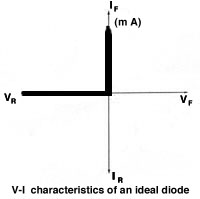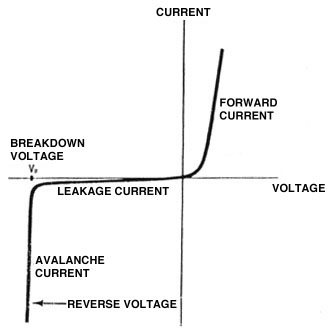In this discussion the term diode and rectifier will be used interchangeably; however, the term diode usually implies a small signal device with current typically in the milliamp range; and a rectifier, a power device, conducting from1 to 1000 amps or even higher. Many diodes or rectifiers are identified as 1NXXXX. A semiconductor diode consists of a PN junction and has two (2) terminals, an anode(+) and a cathode(-). Current flows from anode to cathode within the diode. A diode and schematic representation are shown below:

An ideal diode is like a light switch in your home. When the switch is closed, the circuit is completed; and the light turns on. When the switch is open, there is no current and the light is off.
This can be shown as:

However, the diode has an additional property; it is unidirectional, i.e. current flows in only one direction (anode to cathode internally). When a forward voltage is applied, the diode conducts; and when a reverse voltage is applied, there is no conduction. A mechanical analogy is a ratchat, which allows motion in one direction only. An ideal diode characteristic would be:

However, a typical diode characteristic is more like the following:

Forward Voltage Drop , Vf
Notice that the diode conducts a small current in the forward direction up to a threshold voltage, 0.3 for germanium and 0.7 for silicon; after that it conducts as we might expect. The forward voltage drop, Vf, is specified at a forward current, If.
Leakage current
In the reverse direction there is a small leakage current up until the reverse breakdown voltage is reached. This leakage is undesirable, obviously the lower the better, and is specified at a voltage less than the breakdown; diodes are intended to operate below their breakdown voltage.
Current Rating
The current rating of a diode is determined primarily by the size of the diode chip, and both the material and configuration of the package, Average Current is used, not RMS current. A larger chip and package of high thermal conductivity are both conducive to a higher current rating.
Switching
The switching speed of a diode depends upon its construction and fabrication. In general the smaller the chip the faster it switches, other things being equal. The chip geometry, doping levels, and the temperature at nativity determine switching speeds. The reverse recovery time, trr, is usually the limiting parameter; trr is the time it takes a diode to switch from on to off.
Conclusion
The very minimal diode specifications are:
(a)Maximum reverse voltage
(b)Rated forward current
(c)Maximum forward voltage drop
(d)Maximum leakage current
(e)Package style
(f)Maximum reverse recovery time


Leave A Comment